As you can see from these covers dating back to 1900, America has always celebrated educational milestones with great pride. We’ve always known that our grads would go on to do amazing things!

Frank X. Leyendecker
May 26, 1900
This cover of President Cleveland and two college graduates was Frank X. Leyendecker’s first cover for the Saturday Evening Post.

Harrison Fisher
June 21, 1902
The most important work of the early Post period was made up of the elegant paintings of Harrison Fisher. He frequently painted covers that simply presented a lovely woman. Occasionally a prop, like the diploma in this 1902 cover, implied a narrative, but the essential subject remained the woman herself.
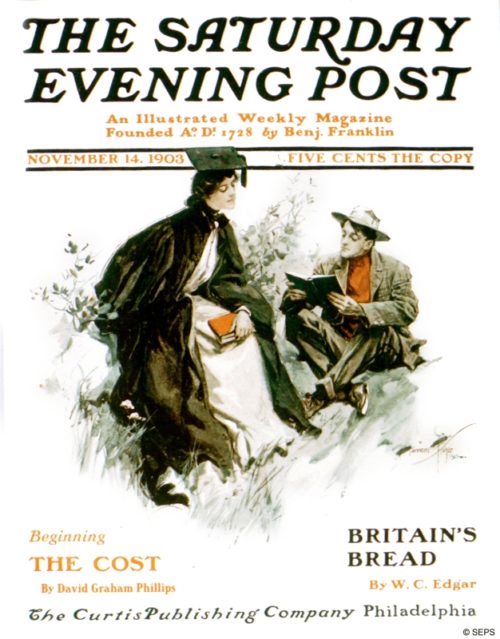
Harrison Fisher
November 14, 1903
This later Harrison Fisher cover shows a couple reading together. Couples doing something romantic was another common theme in Fisher’s covers. Since painting women was his specialty, the woman graduate still remains the focus of this cover.
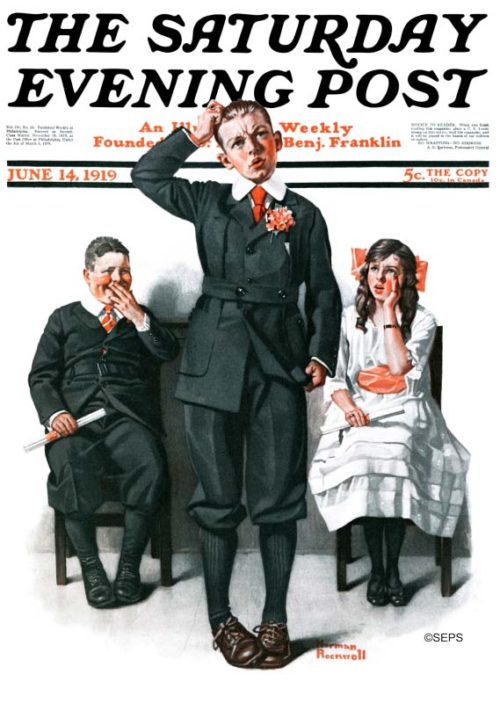
Norman Rockwell
June 14, 1919
This Rockwell cover shows a young student trying to remember his graduation speech. By the look on his face, he doesn’t hear the helpful hints or laughter coming from behind him.
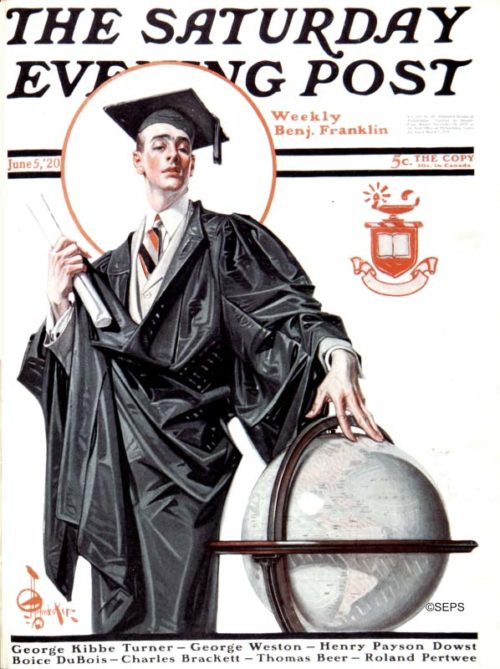
J.C. Leyendecker
June 5, 1920
This J.C. Leyendecker cover shows a college graduate ready to take on the world. Strong male figures were a trademark of many of Leyendecker’s Post covers.

E.M. Jackson
June 3, 1922
This is one of more than 30 covers E.M. Jackson created in the 1920s. While Jackson was mostly known for his paintings of romantic women, he occasionally created a cover focused on a man, like this graduate dressed as a Roman, giving his commencement speech.

Edmund Davenport
June 13, 1925
This is Edmund Davenport’s third and final cover for the Saturday Evening Post. The clouds behind this graduate make this cover unique and complex compared to Davenport’s other two covers, which have more simple backgrounds.
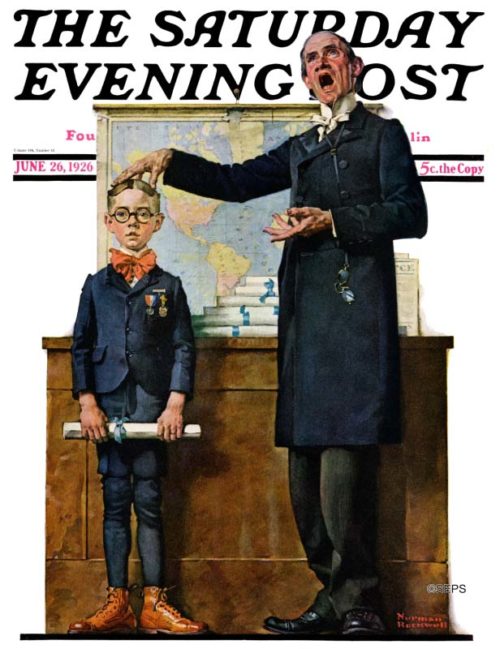
Norman Rockwell
June 26, 1926
In this Rockwell cover a professor hands a young boy his diploma and praises his hard work. It’s assumed that he’s the first in his class based on the large stack of diplomas behind him and the medals on his jacket.
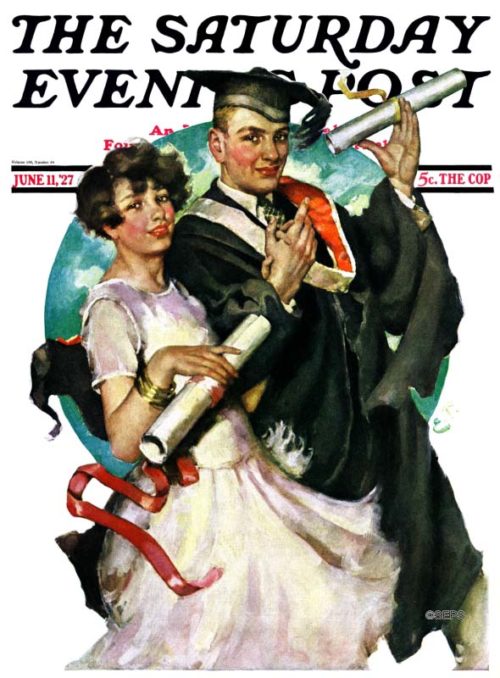
Ellen Pyle
June 11, 1927
This cover was done by one of the Post’s most prolific female artists, Ellen Pyle. Her early Post covers were simple portraits of women. Later on, her work became more detailed and many of her covers have the subject in front of a large, colored circle in the background, just like these graduates on her 1927 cover.

McClelland Barclay
June 7, 1930
This McClelland Barclay cover of a military school graduate and his girl is similar to nearly every other Barclay Post cover. Barclay became well known for his ability to paint strikingly beautiful women in a rather simple setting using bold colors. Barclay painted a total of five Saturday Evening Post covers, and all but one depicts a vibrant couple with an empty background.

Stevan Dohanos
June 5, 1948
Steve Dohanos’ two sons, Peter and Paul, were in an Eastern boys’ school when he took the family car up to help them move home. A passenger car, he learned, is no proper vehicle for such a job. The artist made his sketches on the Yale campus, but rearranged things to suit his purposes. The boy is George Ritter, of Westport, Connecticut, no Yale man. The artist didn’t use a Yale man, on the remarkable theory that none would like to cut class.
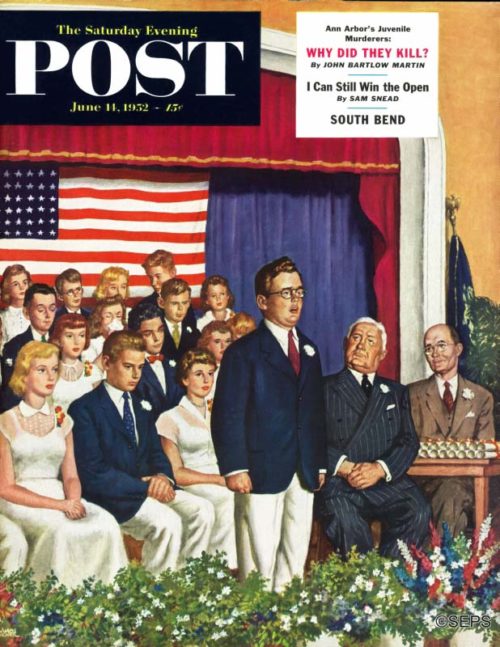
Amos Sewell
June 14, 1952
Once, years ago, a young scholar arose at commencement time to deliver an oration on the Panama Canal, found he had forgotten his entire speech, and started ad-libbing out of the general mass of data he had acquired in the classroom. Everybody vowed it was a grand speech, except his elocution teacher, who nearly had a stroke trying to locate him on her prompting manuscript.
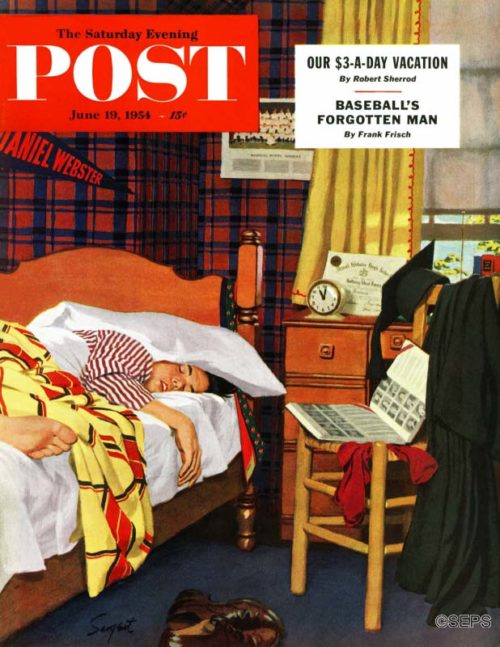
Richard Sargent
June 19, 1954
Now that this young man is going forth from the halls of learning, maybe he is lying there thinking about how his generation soon will he the guardians of civilization, and of what a glorious challenge this is to the youth of today. Or maybe he is asleep. For as Dick Sargent muses with his brush: any guy who manages to finish commencement certainly has forty thousand winks coming.

George Hughes
June 7, 1958
Symbolic of a host of graduating Americans, they have an air of quiet confidence, suggesting that as they help mold the future of this cantankerous old world they may be able to make it behave a little better than in the past. Artist George Hughes worked on this cover at Williams College, where everybody did everything possible to make his stay agreeable—well, short of giving him a degree.

Norman Rockwell
June 6, 1959
Artist Norman Rockwell sketched a couple of undaunted graduates (see below); but then, reflecting on the awfulness of today’s newspaper headlines, he created the bewildered chap on the cover. This one is musing. Boy. aren’t things really screwed up? What to do, I wouldn’t know. But one thing you can bet on: I’ll give it the old college try. Rockwell says, “I like his feet. They look as if he’s standing on eggs.”


Thornton Utz
June 4, 1960
Artist Thornton Utz’s scene is Smith College, in Northampton, Massachusetts, where in 1960, Congressman Chester Bowles delivered the commencement address. The congressman’s daughter Sarah was among the 500 young ladies receiving bachelor degrees.
Become a Saturday Evening Post member and enjoy unlimited access. Subscribe now
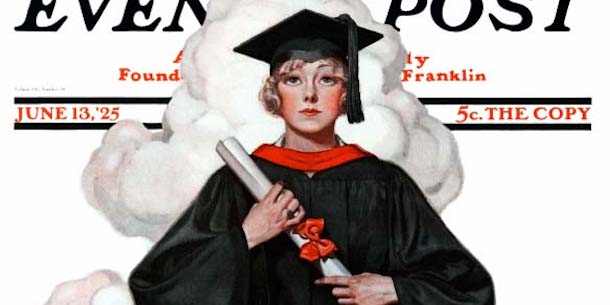



Comments
The lady on the 1902 cover by Harrison Fisher looks a little ticked off to me, it’s probably due to the cover blubs taking up most of the space.
In the 1903 cover the lady doesn’t look happy either. Maybe that’s because she’s out in nature somewhere (in the snow?) wearing a cap and gown.
In Rockwell’s 1919 cover, this boy should have been allowed to have notes to glance down to, to avoid this situation. But as we know, school is really all about regurgitation, not learning. That’s sad. I love to learn new things everyday!
I can’t tell if the young woman sitting on top of the world (well, a globe) is worried or just what. She’s probably wondering if it was all worth it. Let’s hope it was, right?
Rockwell’s 1926 cover is beautifully done of course, and really shows the awkwardness of this whole situation.
I really like Ellen Pyle’s work, but can’t get a good read on what they’re thinking. She apparently took off her robe (?) while he kept his on. She looks very tired to me.
The 1930 McClelland Barclay cover is beautiful, and uses the classic background circle in an almost invisible way.
Dohanos’s 1940 cover is distinctively his, with amazing detail to be really studied for quite awhile. As far as the situation itself goes, this pet daddy says oh hell no, to ALL of it.
No one looks very happy on the June 14, 1952 cover either.
‘Sleeping In’ is another great Richard Sargent cover nice and quiet, with no dog anywhere to be found.
Very few people look happy on this George Hughes 1958 cover either. It’s kind of a running theme through nearly all of these selections today. In any event, it’s one of his best covers and an interesting departure from most of his others.
Rockwell’s 1959 cover is very unusual and thought provoking.
The bottom cover is another beauty by Thornton Utz, another favorite of mine. Quite a contrast from his ‘Unwanted Pool Guests’ cover in 1961.
It appears former President Cleveland posed the ugly question of ‘Does a College Education Pay?’ 117 years ago, and again in June 1962. The brain washing, scare tactics, have only intensified to an unprecedented degree since.
Not only do the cap and gown look the same, college has not fundamentally changed very much since 1900 either. They have a strangle hold monopoly on the American public. It’s a one-size-fits-all mentality only; no thinking outside the box. Almost no practical alternatives to earn-while-you-learn a trade in a much shorter amount of time, debt free, with high earning power from the get go. Europe nailed that one generations ago, thank you.
The greedy “college machine” couldn’t have that, anymore than the Big 3 couldn’t and wouldn’t allow ‘threats’ to their exclusive auto dominance. Check out the 1988 movie ‘Tucker: A Man and His Dreams’ with Lloyd Bridges.
As for college, check out the one-hour documentary ‘The College Conspiracy’ here online, please. Don’t worry though. It doesn’t even touch on fraternities and how many NAIVE, drunk boys for generations have come CRASHING down flights of stairs head first, with plenty of “brothers” watching, and no one doing a thing at the time, even if it was already too late. How about their being HUGE hotbeds of really vicious racism, and other nightmares that have no place there or anywhere in a supposedly ‘educated’ society?
Fraternities ARE the true face/microcosm of college. They’re the real, no-holds-barred mental and physical versions of the toxic hazing the system as a whole does to the public. Absolutely made for each other. How much “tuition” money is, in fact, being paid by the colleges to the parents of their dead or maimed for life sons to keep quiet?!
Very few people are attending these places because they want to, much less there to learn. Please. How else can you explain the “education nation” now being the laughingstock of the world of the lowest common denominator? ‘The Emperor’s New Clothes’ with the U.S. admiring itself in the mirror.